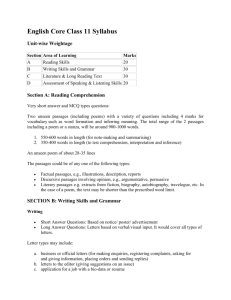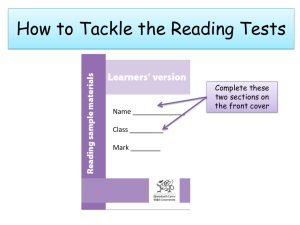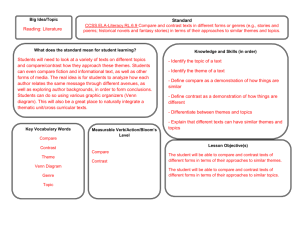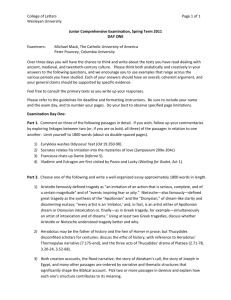Text Selection Guidelines Chart Grades 3-8
advertisement
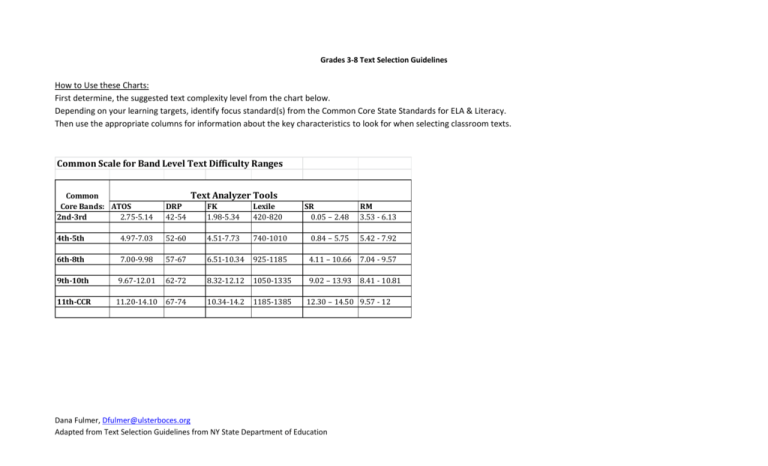
Grades 3-8 Text Selection Guidelines How to Use these Charts: First determine, the suggested text complexity level from the chart below. Depending on your learning targets, identify focus standard(s) from the Common Core State Standards for ELA & Literacy. Then use the appropriate columns for information about the key characteristics to look for when selecting classroom texts. Common Scale for Band Level Text Difficulty Ranges Text Analyzer Tools Common Core Bands: ATOS 2nd-3rd 2.75-5.14 DRP 42-54 FK 1.98-5.34 Lexile 420-820 4th-5th 4.97-7.03 52-60 4.51-7.73 6th-8th 7.00-9.98 57-67 9th-10th 9.67-12.01 11th-CCR 11.20-14.10 SR 0.05 – 2.48 RM 3.53 - 6.13 740-1010 0.84 – 5.75 5.42 - 7.92 6.51-10.34 925-1185 4.11 – 10.66 7.04 - 9.57 62-72 8.32-12.12 1050-1335 9.02 – 13.93 8.41 - 10.81 67-74 10.34-14.2 1185-1385 12.30 – 14.50 9.57 - 12 Dana Fulmer, Dfulmer@ulsterboces.org Adapted from Text Selection Guidelines from NY State Department of Education R1: Support claims with evidence 3-5 Must have sufficient detail WHAT to support basic TO literal questions LOOK & minor FOR inferences 6-8 Passages must contain WHAT sustained TO development to LOOK analyze for FOR content & craft. Concepts developed with multiple details R2: Determine central ideas or themes & analyze development; summarize Must have a central clear idea. Grade 5: 2 central ideas Has concepts with multiple ideas. Passages that can be summarized in 12 sentences are not complex enough. INFORMATIONAL TEXT Characteristics to Look For in Selecting Text R3: Analyze how R4: R5: Analyze text R6: Point of View R7: ideas develop & Interpret structure Integrating interact words & from phrases diverse formats Must contain concepts, descriptions built with multiple steps. Rich in grade-level vocabulary Texts with clear organization of ideas. (Gr 5: compare multiple texts) Must contain concepts, descriptions complex enough to support analysis of parts, and to the utilization of a 3rd concept for analysis (influence, contrast, etc.) Contain figurative language &/or stylistic choices sufficient to support analysis. Rich in organizational development; well-developed paragraphs. Dana Fulmer, Dfulmer@ulsterboces.org Adapted from Text Selection Guidelines from NY State Department of Education Passages with a distinct point of view that is developed through the text. Gr 4 & 5: paired passages on same event. Passages with clear purposes & points of view that are significantly developed with clear authorial techniques. (Persuasive texts like op-ed are ideal.) Texts with illustrations, graphs, maps, charts. Gr 5: multimedia Different types of sources. R8: Evaluating claims & reasoning R9: Analyze multiple texts Contain ideas developed with comparisons , cause & effect, sequences. Gr 4 & 5: include authorial claims Multiple claims & pieces of evidence. Gr 8: some evidence that is questionable or irrelevant. (Op ed, long ads, political propaganda & speeches) Paired Passages: Different info on same topic to build understanding 6: Same topic covered by different authors, presented differently. 7-8: Different interpretations emphasizing different evidence. 8: Conflicting interpretations R1: Support claims with evidence 3-5 6-8 Passages must have sufficient details to support basic literal questions & minor inferences Passages must contain sustained development to analyze for content & craft. Plots, characters & themes developed with multiple details LITERARY TEXTS Characteristics to Look for in Selecting Text R4: Interpret R5: Analyze text R6: Point of R7: words & structure View Integrating phrases from diverse formats R2: Determine central ideas or themes & analyze development; summarize Must have a central clear idea. Grade 5: 2 central ideas R3: Analyze how ideas develop & interact Must contain clear significant characters with detailed characterized. Rich in gradelevel language & by grade 5, figurative language Story events should be distinct & contribute clearly to plot. Clear point of view: gr 4: first & third person narrators. Illustrations or multimedia. Paired: similar themes 3: Same author 4: Different cultural traditions 5: Same genre, different author Has concepts with multiple ideas. Passages that can be summarized in 12 sentences are not complex enough. Clear characters who develop over a sequence of Contain figurative language & stylistic choices. Poetry an excellent choice for this standard. Rich in structural development (chapters, scenes, stanzas) to support analysis. Layered meanings. Multiple characters with different perspectives; gr 8: irony. Video versions of stories & plays. 6: Same theme, diff. form or genre 7: Fictional & historical accounts 8: Cultural & textual allusions in a text Dana Fulmer, Dfulmer@ulsterboces.org Adapted from Text Selection Guidelines from NY State Department of Education R8: Evaluating claims & reasoning R9: Analyze multiple texts PAIRED TEXTS 3-5 Expository Argumentative Expository: Ideas developed over several paragraphs; strong organizational structure; grade level language Clear point of view, Multiple points of evidence; Strong organizational structure 3-5: 2 complementary points of view that build understanding Argumentative Multimedia Clear point of view & purpose Argument developed over several paragraphs Valid reasoning supported by multiple pieces of evidence 6-8: Opposing points of view 8: Include some questionable reasoning Paired Multimedia Narrative Poetry Narrative: Passages relate the same event or significant moment; several paragraphs; several key points with descriptive details. Relate the same event. Narrative builds through elaboration of several key points, with descriptive details for each. Strong organizational structure. Clear themes developed with multiple images or details Clear themes 3: Different texts from same author 4: Similar themes, different cultures 4-5: Two different media, complementary points of view 6-8 Narrative Two opposing points of view Built on differently interpreted evidence Media itself should be highlight differences in interpretation 5: Different authors, same genre 4: Similar themes, different cultures, different media Provide complementary points of view Narrative: Passages relate the same event or significant moment; several paragraphs; several key points with descriptive details. 6: Similar theme, different genres 7: Similar theme or event; pair fictional & informational accounts Provide opposing points of view Dana Fulmer, Dfulmer@ulsterboces.org Adapted from Text Selection Guidelines from NY State Department of Education Two different media, Two complementary points of view 5: Different authors, same genre, different media (e.g. mystery story & film) Two opposing points of view 6: Similar event/theme, different genres & media 7: Fictional & historical accounts in different media Structure enhances meaning Use of figurative devices


